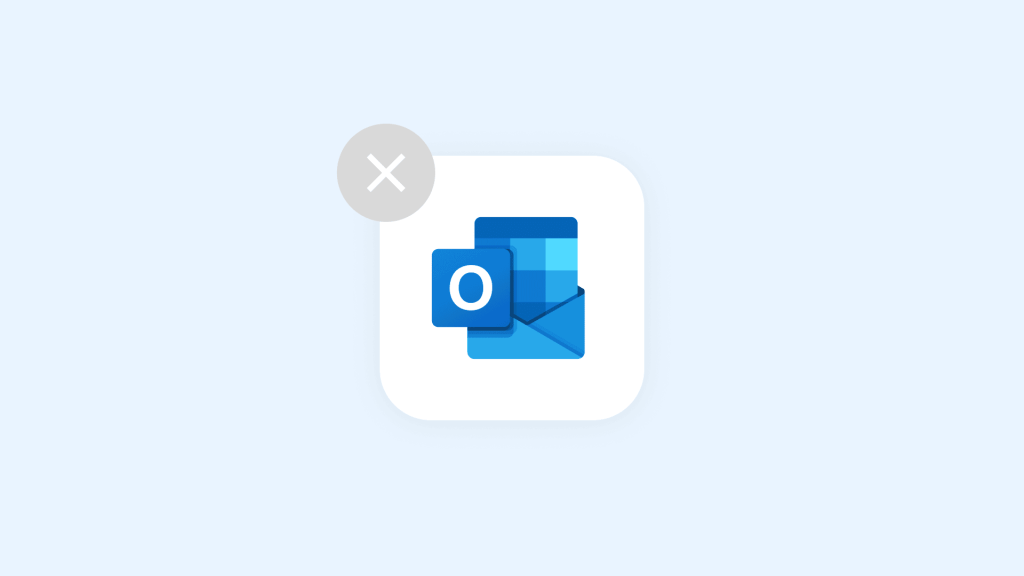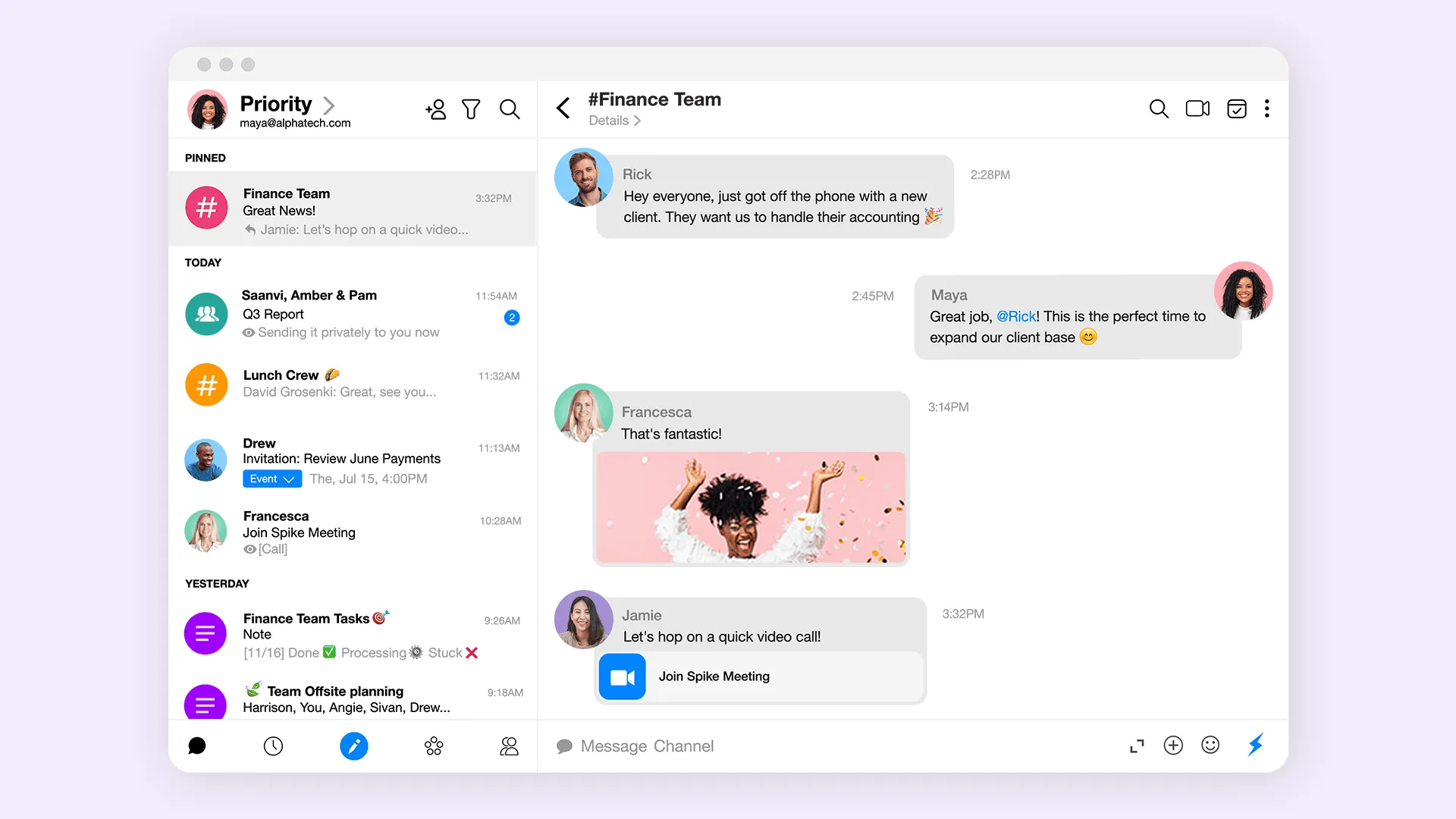The 8 best Microsoft Outlook alternatives for 2025

Microsoft Outlook dominates corporate email because it handles the basics reliably and integrates with Microsoft’s ecosystem. But here’s what teams discover after years of using it: Outlook optimizes a fundamentally broken email experience instead of fixing the actual problem.
Traditional email splits every conversation into separate message documents. You get a new email for each reply, forward, and person added to the thread. What should flow as one conversation becomes scattered fragments you reconstruct mentally every time you check your inbox.
This creates the email reconstruction problem that burns hours daily. You open a thread and immediately start detective work:
Who said what when?
Where’s the actual decision?
Instead of communicating, you’re doing forensic analysis on your own conversations.
Most Outlook alternatives merely optimize this broken system more efficiently. They add AI to help you manage chaos, keyboard shortcuts to navigate scattered messages, and better search to find buried information. They’re still forcing you to do mental reconstruction work that shouldn’t exist.
Spike pioneered a different approach by recognizing that email’s fundamental design needed evolution, not optimization. Instead of helping users manage email chaos more efficiently, Spike eliminated the chaos by showing conversations as flowing timelines. This conversational email design sparked the industry trend you now see everywhere.
The choice isn’t between different email clients anymore. It’s between email evolution that eliminates cognitive overhead and email optimization that helps you manage it faster.
Why teams look beyond Outlook
Outlook’s limitations become obvious once work shifts to continuous collaboration. The threading structure works for occasional formal correspondence but breaks down when communication becomes conversational and frequent.
- Context switching overhead: Outlook requires constant mental reconstruction of conversation history. Teams report spending 40% more time managing communication overhead compared to conversation-flow alternatives.
- External collaboration friction: Adding clients to email conversations creates fragmentation problems. External stakeholders see scattered message documents instead of coherent discussion flow.
- Interface complexity: Outlook’s feature density creates navigation complexity that increases with updates. Teams need weeks to master workflows that should be intuitive.
Mobile experience gaps. Outlook’s mobile apps compress desktop complexity into phone screens, creating usability problems for the 62% of business email that opens on mobile devices.
The 8 best Outlook alternatives for 2025
1. Spike: The conversational email pioneer

Spike solves the fundamental problem that all other alternatives work around: email threading forces mental reconstruction of conversations that should flow naturally. Spike pioneered the conversational email design that eliminated email reconstruction entirely.
Instead of separate message documents, Spike displays email conversations as flowing timelines. All communication appears in chronological order, like messaging apps, while maintaining email compatibility.
Key Features:
- Conversational email design that shows conversations as flowing timelines instead of scattered message documents.
- Clean, sequential data format that enables remarkably accurate.
- AI features for summaries, prioritization, reply generation.
- Universal email compatibility that allows external partners to participate naturally without app downloads.
- Integrated task and document management seamlessly within email conversations.
- Built-in video conferencing and team collaboration tools.
- Priority inbox that focuses attention on important communications.
Works on: PC, Mac, Android, iPhone
Pricing: Plans from $5 per user, monthly.
2. Missive: Team email collaboration

Missive is an email client designed for collaboration among teams. Discuss emails using internal comments, turn emails into tasks, and build automated workflows using its flexible rules.
If your inbox is your central communication hub, pull in more context with Missive’s 25+ integrations or build your own using its API. Missive supports all email providers and is available on all platforms (Windows, Android, iOS, Mac).
Key Features:
- Internal comments: Discuss emails, loop in team members, without ever forwarding.
- Multi-channel support: Connect email, WhatsApp, SMS, live chat, and more.
- AI Rules: Auto-assignment, custom SLAs, auto-categorization, auto-follow ups, and more.
Pricing: Free plan up to 3 users and 15-days of history, with paid plans starting at $14/user/month
3. Superhuman: Premium email optimization
Superhuman represents the peak of traditional email optimization. Lightning-fast keyboard shortcuts, AI-powered inbox management, and interface refinements make processing threaded email faster than any other client.
Superhuman delivers on its speed promises. Users process traditional email significantly faster through extensive keyboard shortcuts and interface optimizations.
Key Features:
- Keyboard-centric interface with shortcuts for every email action.
- AI-powered inbox management and triage.
- Read receipts and email tracking capabilities.
- Integration with popular productivity tools.
Works on: Mac, PC, iOS, Android
Pricing: $30 per user/month
4. Gmail: Google’s email powerhouse
Gmail remains the most widely used email platform globally, known for its robust performance, extensive integrations with Google’s ecosystem, and powerful spam filtering. The conversation view groups related messages together, making it easier to follow email threads.
However, Google’s data collection practices concern many businesses. Storage sharing across Gmail, Drive, and Photos creates practical limitations for heavy email users.
Key Features:
- Seamless integration with Google Workspace tools.
- Strong spam filtering and security features.
- 15GB of free storage for personal use.
- Advanced search functionality.
Works on: Mac, PC, iOS, Android
Pricing: Google Workspace plans start at $6 per user/month.
5. ProtonMail: Security-first traditional email
ProtonMail prioritizes privacy through end-to-end encryption while maintaining traditional email interfaces. End-to-end encryption works transparently, and the open-source codebase allows security auditing.
Key Features:
- End-to-end encryption for all emails and attachments.
- Secure calendar and file storage integration.
- Anonymous email accounts available.
- Open-source code that can be independently audited.
Works on: Mac, PC, iOS, Android
Pricing: Premium plans start at $4 per month.
6. HEY: Opinionated email workflow
HEY implements specific workflow philosophies through forced processes. The screening system and bundling features create structured approaches to inbox management that force users into specific email handling patterns.
Key Features:
- Clean, distraction-free interface design.
- Reply later functionality for better email timing.
- Imbox (not inbox) philosophy for important emails only.
- Automatic email bundling and categorization.
Works on: Mac, PC, iOS, Android
Pricing: Paid plans start at $12/user per month.
7. Mailbird: Windows customization hub
Mailbird specializes in Windows email with extensive customization options and third-party app integrations. Connects email with WhatsApp, Twitter, Dropbox, and productivity applications within a single interface.
Interface themes, layout options, and workflow customizations allow teams to tailor the email experience to specific preferences. However, the Windows-only availability creates adoption barriers for mixed-platform teams.
Key Features:
- Unified inbox for managing multiple email accounts.
- Customizable interface themes and layouts.
- Touch and gesture support for Windows devices.
- Extensive app integrations.
Works on: Windows only
Pricing: Paid plans start at $2.50/month.
8. Zoho Mail: Business suite integration
Zoho Mail operates as part of Zoho’s comprehensive business software ecosystem, providing email that integrates with CRM, project management, and collaboration tools within their platform.
For businesses already using Zoho’s suite, email integration with existing business processes happens automatically. Customer communications connect directly to CRM records and project contexts.
However, teams using different business software miss integration benefits and may find limited value in the email-only offering.
Key Features:
- Ad-free business email experience.
- Deep integration with Zoho’s suite.
- Custom domain support and professional branding.
- Advanced security and compliance features.
Works on: Web, Mac, PC, iOS, Android
Pricing: Paid plans start at $1 per user/month.
How to choose between email evolution and email optimization
The decision framework comes down to recognizing whether you want to optimize traditional email faster or evolve beyond email’s fundamental limitations.
Communication patterns:
Teams that default to email despite trying chat alternatives often benefit more from email evolution approaches like Spike than from optimizing traditional email interfaces they naturally avoid.
External collaboration requirements:
If client communication drives significant team discussions, evolution solutions that work universally typically succeed better than optimization tools that create separate internal and external communication systems.
Cognitive overhead tolerance:
Each threaded email client requires mental reconstruction work that compounds daily. Evolution approaches eliminate this overhead while optimization approaches help you manage it more efficiently.
Most teams choose based on features rather than asking whether they want to optimize broken systems or evolve beyond the limitations entirely.
The future of business email
The workplace transformation trend is accelerating toward communication evolution rather than traditional email optimization. AI capabilities reach full potential when conversation data flows cleanly instead of being scattered across threaded message documents.
Spike’s conversational email design represents where business communication is heading. Tools that work with natural human communication patterns, rather than forcing adaptation to 1970s document paradigms. The companies that recognize this evolution first gain decisive advantages in coordination speed and external collaboration effectiveness.
The choice isn’t between different email clients anymore. It’s whether you want to keep optimizing email reconstruction or participate in the communication transformation that eliminates the need for reconstruction entirely.




